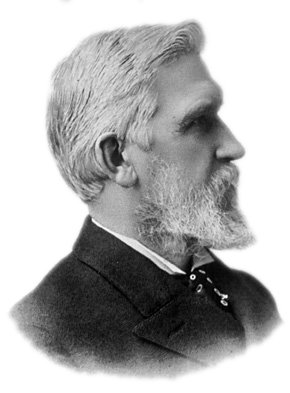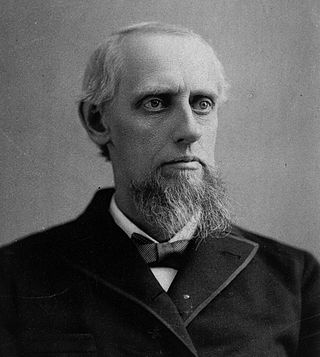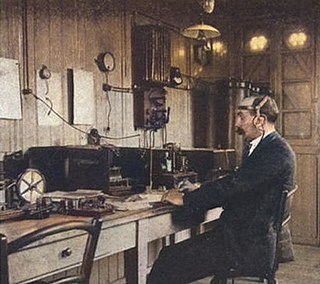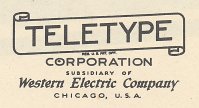Related Research Articles

Electrical telegraphs were point-to-point text messaging systems, primarily used from the 1840s until the late 20th century. It was the first electrical telecommunications system and the most widely used of a number of early messaging systems called telegraphs, that were devised to communicate text messages quicker than physical transportation. Electrical telegraphy can be considered to be the first example of electrical engineering.

Guglielmo Giovanni Maria Marconi, 1st Marquis of Marconi was an Italian inventor and electrical engineer, known for his creation of a practical radio wave–based wireless telegraph system. This led to Marconi being credited as the inventor of radio, and he shared the 1909 Nobel Prize in Physics with Karl Ferdinand Braun "in recognition of their contributions to the development of wireless telegraphy".

Telegraphy is the long-distance transmission of messages where the sender uses symbolic codes, known to the recipient, rather than a physical exchange of an object bearing the message. Thus flag semaphore is a method of telegraphy, whereas pigeon post is not. Ancient signalling systems, although sometimes quite extensive and sophisticated as in China, were generally not capable of transmitting arbitrary text messages. Possible messages were fixed and predetermined and such systems are thus not true telegraphs.

A teleprinter is an electromechanical device that can be used to send and receive typed messages through various communications channels, in both point-to-point and point-to-multipoint configurations.

Wireless telegraphy or radiotelegraphy is transmission of text messages by radio waves, analogous to electrical telegraphy using cables. Before about 1910, the term wireless telegraphy was also used for other experimental technologies for transmitting telegraph signals without wires. In radiotelegraphy, information is transmitted by pulses of radio waves of two different lengths called "dots" and "dashes", which spell out text messages, usually in Morse code. In a manual system, the sending operator taps on a switch called a telegraph key which turns the transmitter on and off, producing the pulses of radio waves. At the receiver the pulses are audible in the receiver's speaker as beeps, which are translated back to text by an operator who knows Morse code.

Chad refers to fragments sometimes created when holes are made in a paper, card or similar synthetic materials, such as computer punched tape or punched cards. The word "chad" has been used both as a mass noun and as a countable noun.
Asynchronous serial communication is a form of serial communication in which the communicating endpoints' interfaces are not continuously synchronized by a common clock signal. Instead of a common synchronization signal, the data stream contains synchronization information in form of start and stop signals, before and after each unit of transmission, respectively. The start signal prepares the receiver for arrival of data and the stop signal resets its state to enable triggering of a new sequence.

Elisha Gray was an American electrical engineer who co-founded the Western Electric Manufacturing Company. Gray is best known for his development of a telephone prototype in 1876 in Highland Park, Illinois. Some recent authors have argued that Gray should be considered the true inventor of the telephone because Alexander Graham Bell allegedly stole the idea of the liquid transmitter from him. Although Gray had been using liquid transmitters in his telephone experiments for more than two years previously, Bell's telephone patent was upheld in numerous court decisions.

Amos Emerson Dolbear was an American physicist and inventor. Dolbear researched electrical spark conversion into sound waves and electrical impulses. He was a professor at University of Kentucky in Lexington from 1868 until 1874. In 1874 he became the chair of the physics department at Tufts University in Medford, Massachusetts. He is known for his 1882 invention of a system for transmitting telegraph signals without wires. In 1899 his patent for it was purchased in an unsuccessful attempt to interfere with Guglielmo Marconi's wireless telegraphy patents in the United States.
Gilbert Sandford Vernam was a Worcester Polytechnic Institute 1914 graduate and AT&T Bell Labs engineer who, in 1917, invented an additive polyalphabetic stream cipher and later co-invented an automated one-time pad cipher. Vernam proposed a teleprinter cipher in which a previously prepared key, kept on paper tape, is combined character by character with the plaintext message to produce the ciphertext. To decipher the ciphertext, the same key would be again combined character by character, producing the plaintext. Vernam later worked for the Postal Telegraph Company, and became an employee of Western Union when that company acquired Postal in 1943. His later work was largely with automatic switching systems for telegraph networks.
John Stone Stone was an American mathematician, physicist and inventor. He initially worked in telephone research, followed by influential work developing early radio technology, where he was especially known for improvements in tuning. Despite his often advanced designs, the Stone Telegraph and Telephone Company failed in 1908, and he spent the remainder of his career as an engineering consultant.

The invention of radio communication was preceded by many decades of establishing theoretical underpinnings, discovery and experimental investigation of radio waves, and engineering and technical developments related to their transmission and detection. These developments allowed Guglielmo Marconi to turn radio waves into a wireless communication system.

The Teletype Corporation, a part of American Telephone and Telegraph Company's Western Electric manufacturing arm since 1930, came into being in 1928 when the Morkrum-Kleinschmidt Company changed its name to the name of its trademark equipment. Teletype was responsible for the research, development and manufacture of data and record communications equipment, but it is primarily remembered for the manufacture of electromechanical teleprinters.
Acoustic telegraphy was a name for various methods of multiplexing telegraph messages simultaneously over a single telegraph wire by using different audio frequencies or channels for each message. A telegrapher used a conventional Morse key to tap out the message in Morse code. The key pulses were transmitted as pulses of a specific audio frequency. At the receiving end a device tuned to the same frequency resonated to the pulses but not to others on the same wire.
Edward Ernst Kleinschmidt was a German-American engineer. He was one of the inventors of the teleprinter, and obtained 118 patents over the course of his lifetime.

John White Howell was an American electrical engineer who spent his entire professional career working for Thomas Edison, specializing in the development and manufacturing of the incandescent lamp.

The printing telegraph was invented by Royal Earl House in 1846. House's equipment could transmit around 40 instantly readable words per minute, but was difficult to manufacture in bulk. The printer could copy and print out up to 2,000 words per hour. This invention was first put in operation and exhibited at the Mechanics Institute in New York in 1844.

Joy Sterling Morton was an American businessman and entrepreneur best known for founding Morton Salt and establishing the Morton Arboretum in Lisle, Illinois.

The Kleinschmidt keyboard perforator is a telegraph instrument invented by Edward Kleinschmidt which prepares punched tape for telegraph transmission. A QWERTY keyboard operate hole punches that prepare a Wheatstone slip. Each Morse code of the dots and dashes for the letter is selected by projecting tongues on the key bar. The centre holes used for the paper feed are punched first, then the lower holes, and then the upper holes. The upper holes are the mark holes, which indicate when the symbol starts, and the lower hole tell when to terminate the symbol. This keyboard can be operated at up to 80 words a minute by a skilled operator.
References
- ↑ Huurdeman, Anton A. (2003-07-31). The Worldwide History of Telecommunications. John Wiley & Sons. p. 301. ISBN 978-0-471-20505-0.
- ↑ Kleinschmidt, Edward E. "Printing Telegraphy ... A New Era Begins, by Edward E. Kleinschmidt: a Project Gutenberg eBook". www.gutenberg.org. Retrieved 2024-01-17.
- ↑ "Charles L. Krum Dies; Coinventor of Teletype". The Indianapolis Star. 1937-09-26. p. 17. Retrieved 2024-01-17.